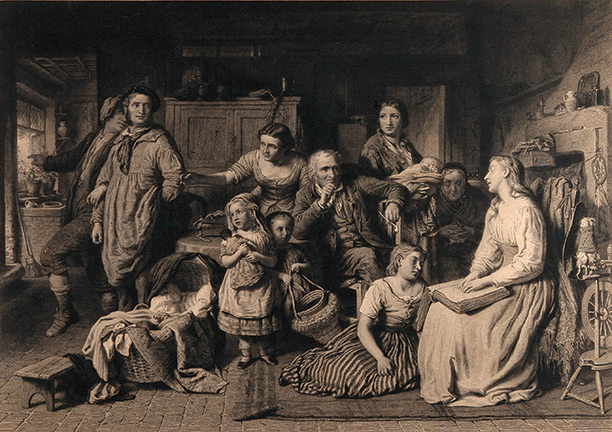Selina Mills attends a conference on the history of blindness, now a dynamic field of study.
 Night and Darkness: a blind girl reads to her family in a 19th-century illustrationBlindness and its history have become fashionable. August saw the opening of Touching the Book,
an exhibition at Birkbeck, University of London chronicling the history
of raised reading before the advent of Braille. Later this year the
National Portrait Gallery is dedicating a room to ‘Facing Blindness’,
portraits of blind and visually imapolitics. In June more than 100
academics attended one of the first major international conferences on
the history of blindness and blind and partially sighted people.
Night and Darkness: a blind girl reads to her family in a 19th-century illustrationBlindness and its history have become fashionable. August saw the opening of Touching the Book,
an exhibition at Birkbeck, University of London chronicling the history
of raised reading before the advent of Braille. Later this year the
National Portrait Gallery is dedicating a room to ‘Facing Blindness’,
portraits of blind and visually imapolitics. In June more than 100
academics attended one of the first major international conferences on
the history of blindness and blind and partially sighted people.It is hardly surprising that blindness, both the physical condition and metaphorical idea, should come under the scrutiny of historians. From the history of science, to philosophy, to social studies, medicine, the history of religion, literature and psychoanalysis, the conference gave a sense of how wide and farreaching blindness as a subject has become. Papers included ‘Different Ways of Seeing in the Middle Ages’, ‘Blindness, Learning and the Politics of Radio in Interwar France’ and ‘What a Blind Man Saw at the International Exhibition of 1862’, which pulled apart the myth of how the blind were inarticulate, muted victims of their condition. An entire afternoon was dedicated to ‘Institutions and Society in the Middle and the Far East’.
There have been conferences on blind people in a smaller capacity in the past. These have tended to focus on the well-known and trusted stars of blind history, such as John Milton, Helen Keller and Louis Braille. But the new flush of interest differs from its predecessors. In the past these colloquiums relied upon a ‘triumph over adversity’ trope, which tends to place the blind person as heroes and heroines who overcame the tragedy of blindness. Some catered only for blind or partially sighted delegates to speak and attend, perpetuating the idea that the sighted and the blind lived and experienced worlds apart. Now, the idea of writing a separate history for blind people has become redundant; the argument goes that we are all part of the same history, blind or sighted.
What has changed? Partly, historians are looking at archives in a different way. Hospital records, plays and literature and diaries of directors of institutions are revealing a wide range of material. Leaders in the field, such as Zina Weygand in Paris and Cathy Kudlick in San Francisco, have shown that delving into old cupboards in blind institutions can allow you to find old notebooks. One, from 1824, was written by a blind woman called Adele Husson, who is frank about how the sighted see the blind:
One looks upon the use of sight as one of the greatest fortunes. I cannot share this opinion. I was deprived of my sight at the age of nine months. I have just reached my 22nd year, and I still don’t remember ever forming a single regret concerning the loss of my eyes ... People who console me hope to better my lot, but alas! they only make it worse.This notebook proves not only that blind people had a voice, but ones that revolted against the calcified views of them. It also established that blind people applied to institutions under their own volition, understanding that, while segregated, a school would grant them opportunity and a safer place in society.
There is also a general shift in mood in both academia and the media. Michel Foucault taught us to look at how societies treat their insane and criminal population to reveal attitudes to humanity and Henri-Jacques Stiker wrote his seminal work on how society creates disability. Their ideas have finally trickled through to those looking at other physical experiences. Thus blindness in the 19th century could reveal how Britain’s imperial ethos lead to the mass building of blind schools, asylums and institutions in the mid-1800s. There are also some high profile blind and partially sighted academics, such as Georgina Kleege at Berkeley and Hannah Thompson at Royal Holloway, who write regularly about their own blindness and partial vision, demystifying the notion that blindness is ‘other’. Blindness and disability are less and less a minority boutique subject, merely one among many topics a historian can draw upon.
There is one surprise in this story; that it has taken so long. Many argue that this is because it is hard to know where to place blindness and its history as a subject – it does not fit into a traditional discipline. But partly, too, there have been quite a few obstacles in gaining access to archives, and connecting, if you will pardon the pun, the pre-Braille dots. As more and more research comes to the fore, it seems that the nature of blindness and other disabilities will provide the key to thinking about our present understanding of blind and partially sighted people. And, above all, allow stories about blind people to emerge from the corridors, into the main room of history.
No comments:
Post a Comment